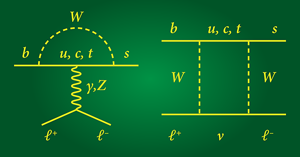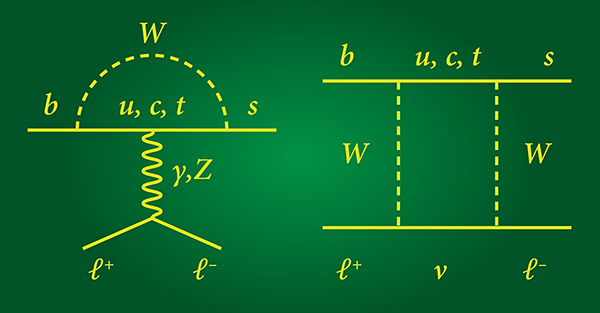A Challenge to Lepton Universality
What is the difference between an electron and a muon? The obvious answer is mass: the muon is about times heavier than the electron. But as far as the standard model of particle physics is concerned, the electron and the muon, which are both leptons, behave the same. More specifically, the way they (and the third type of lepton, the tau particle) interact with other particles, either via the electromagnetic force or the weak force, is identical.
This idea, known as lepton universality, is being challenged by a new result from scientists running the LHCb experiment at the Large Hadron Collider. The researchers analyzed particles produced in the decay of mesons, measuring the ratio of those decays that produced a meson (kaon) and two muons to those that produced a meson and two electrons [1]. The standard model predicts this ratio, , should, to an excellent approximation, be 1. But LHCb found a value for of , implying that decays into electrons are favored with respect to decays into muons. The observed value differs from unity by standard deviations, less than the standard deviations particle physicists require before claiming a discovery. Yet, if substantiated by further data, the finding would imply a striking breakdown of the standard model and clear evidence for a new kind of interaction that violates lepton universality—a surprising and view-changing discovery.
How is measured? The LHCb scientists analyzed the decay of mesons, which are quark-antiquark pairs, one of which is a bottom quark. Bottom quarks are inherently unstable, so mesons quickly decay to mesons containing lighter quarks. The vast majority of these decays occur via processes that involve both a change in quark flavor and a change in electrical charge. But a small fraction (roughly one in ten million) decay with zero change in charge via a “flavor-changing neutral current” (FCNC) process that produces a meson (a meson containing a strange quark) and a pair of oppositely charged leptons—either an electron and an antielectron (positron) or a muon and an antimuon (Fig.1).
The ratio, which compares the relative probability (or “branching fraction”) of these two kinds of decays, is a particularly sensitive place to look for physics beyond the standard model. The reason is that FCNC processes in the standard model have only a small (almost zero) probability of occurring, as they are suppressed by a number of mechanisms. But these mechanisms don’t have to be at work in beyond-standard-model theories, making any new physics easier to see. Studying FCNC processes is one of the key research directions in particle physics theory and experiment.
At the LHC, proton-proton collisions produce copious numbers of bottom quarks and antiquarks, most of which become mesons. So far, LHCb has collected 260 billion bottom-quark antiquark pairs in experimental runs using protons with and tera-electron-volt (TeV) center-of-mass energies. Because they are dealing with a large number of events, they were able to limit their analysis of final-state particles to an energy window with a low background, a key way to reduce the measurement’s uncertainty. Thanks to the large number of bottom quarks and antiquarks, and a dedicated detector they specifically designed to study -meson decays, the researchers have been able to measure with much greater experimental precision than was previously possible.
If the deviation from is pointing to new physics, then why hasn’t this new physics been detected in other experiments? For one, no experiment has had as large a data sample as LHCb. Previous measurements of at electron-positron colliders [2,3] had significantly larger uncertainties and were consistent with lepton universality. The second reason is that is an exceptionally “clean” place to look for violations of lepton universality: effects that limit the precision with which its numerator and denominator can be independently calculated or measured cancel out in their ratio [4].
Given that standard model predictions have already been submitted to very stringent tests, can the observed value of be accommodated by realistic models? The answer is yes, in part because is so clean and in part because is quite specific. In fact, an economical way to extend the standard would be to simply add new interactions that couple electrons and/or muons to the bottom and strange quarks. A few example models that include this type of interaction can explain LHCb’s finding. One example predicts a new field that couples to muons and taus, but not to electrons [5]. Another predicts hypothetical particles called leptoquarks, which are bosonic particles that can mediate the FCNC decay but do so differently for decays resulting in muons and electrons [6]. In the latter case, the observed value of , together with other experimental constraints, suggests that if leptoquarks exist they have mass between and about TeV. Existing experiments could look for the lighter-mass leptoquarks at the LHC, while planned colliders that operate at higher energies could look for the heavier leptoquarks.
What’s next? The findings by the LHCb team should inspire new theoretical studies of flavor-changing processes and new experimental searches at high-energy colliders. Whatever new physics contributes to should show up in other processes that involve FCNC modes. If, in fact, the apparent difference between muons and electrons arises because yet-to-be-discovered particles interact differently with muons and electrons, then experiments should search for these particles. If the LHCb measurement stands up to further experiments, then it will mark a very specific signal of a breakdown of the standard model, and one that guides new models. While a hint is a hint, it could be that we are already seeing a glimpse of new physics.
This research is published in Physical Review Letters.
References
- R. Aaij et al. (LHCb Collaboration), “Test of Lepton Universality Using Decays,” Phys. Rev. Lett. 113, 151601 (2014)
- J.-T. Wei et al. (Belle Collaboration), “Measurement of the Differential Branching Fraction and Forward-Backward Asymmetry for ,” Phys. Rev. Lett. 103, 171801 (2009)
- J. P. Lees et al. (BABAR Collaboration), “Measurement of Branching Fractions and Rate Asymmetries in the Rare Decays ,” Phys. Rev. D 86, 032012 (2012)
- G. Hiller and F. Krüger, “More Model Independent Analysis of Processes,” Phys. Rev. D 69, 074020 (2004)
- W. Altmannshofer, S. Gori, M. Pospelov, and I. Yavin, “Dressing in Color,” Phys. Rev. D 89, 095033 (2014)
- G. Hiller and M. Schmaltz, “ and Future BSM Opportunities,” Phys. Rev. D 90, 054014 (2014)





